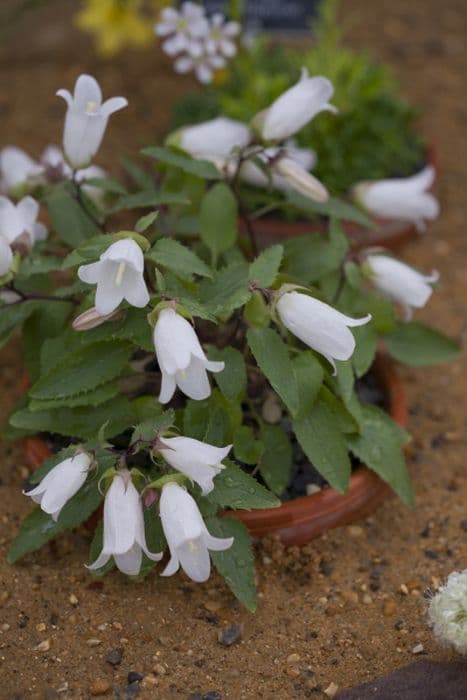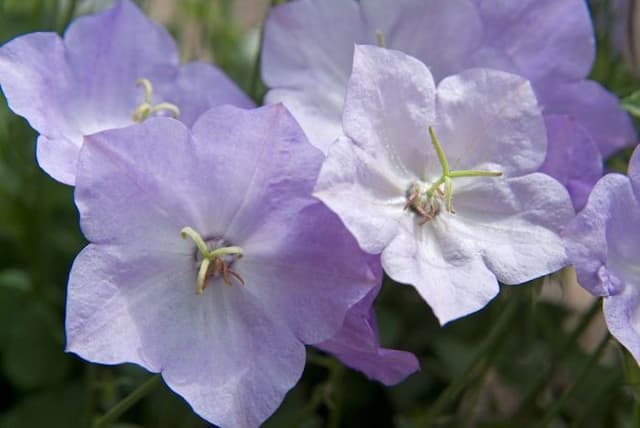Great Bellflower Campanula latiloba 'Alba'

ABOUT
Campanula latiloba 'Alba', commonly known as the Great Bellflower, is a perennial flowering plant. It presents itself with a charming, classic appearance that includes a basal rosette of foliage from which emerges its upright flower stalks. The leaves are generally ovate to lance-shaped, featuring a medium to dark green color with serrated margins, and they can have a slightly hairy texture. The Great Bellflower is most widely recognized for its stunning bell-shaped white flowers that bloom profusely atop these tall, slender stalks. Each of these radiant flowers consists of fused petals that form the characteristic bell shape, opening slightly at the mouth to reveal the flower's interior. The blooms form an elegant array and carry a subtle grace that can enliven any garden space. The overall impression of the plant is one of a serene and graceful specimen with a penchant for classical beauty, drawing the eye with its pure white blossoms set against the backdrop of verdant foliage.
About this plant
 Names
NamesFamily
Campanulaceae
Synonyms
Great Bellflower, Wide-leaved Bellflower, Giant Bellflower
Common names
Campanula latiloba 'Alba'.
 Toxicity
ToxicityTo humans
The Great Bellflower (Campanula latiloba 'Alba') is generally considered to be non-toxic to humans. There is no widely recognized evidence to suggest that ingestion of this plant would cause poisoning or adverse health consequences.
To pets
Similarly, for pets, the Great Bellflower is not known to be toxic. Pets that consume parts of this plant are unlikely to experience poisoning or negative health effects as a result of ingestion.
 Characteristics
CharacteristicsLife cycle
Perennials
Foliage type
Deciduous
Color of leaves
Green
Flower color
White
Height
2-3 feet (60-90 cm)
Spread
1-2 feet (30-60 cm)
Plant type
Herb
Hardiness zones
3-9
Native area
Europe
Benefits
 General Benefits
General Benefits- Aesthetic Appeal: Campanula latiloba 'Alba', commonly known as the Great Bellflower, produces beautiful white bell-shaped flowers that add elegance and charm to any garden setting.
- Attracts Pollinators: The flowers are rich in nectar, attracting bees, butterflies, and other beneficial pollinators, contributing to the health of the ecosystem.
- Low Maintenance: Once established, the Great Bellflower is relatively easy to care for, requiring minimal attention beyond basic watering and occasional feeding.
- Tolerance to Various Conditions: This plant is tolerant of a variety of soil types, although it prefers well-drained soils, and it can handle partial shade to full sun.
- Herbaceous Perennial: As a perennial, it returns for several seasons, providing long-term value in the landscape without the need for replanting each year.
- Border Planting: Its upright habit and clump-forming nature make it an excellent choice for borders, adding structure to garden designs.
- Cottage Garden Style: The Great Bellflower fits well into cottage garden schemes, contributing to a relaxed and naturalistic feel.
- Versatility: It can be used in various garden settings such as formal beds, rockeries, and wildflower meadows.
- Garden Ecosystem: Besides attracting pollinators, it can provide shelter for small wildlife and contributes to biodiversity.
- Seasonal Interest: Campanula latiloba 'Alba' blooms in early to mid-summer, providing a display of color when many other plants may not be flowering.
 Medical Properties
Medical PropertiesThis plant is not used for medical purposes.
 Air-purifying Qualities
Air-purifying QualitiesThis plant is not specifically known for air purifying qualities.
 Other Uses
Other Uses- Campanula latiloba 'Alba', commonly known as the Great Bellflower, can be used in floral arrangements due to its tall, elegant stalks and pure white, bell-shaped flowers, providing a delicate accent to both fresh and dried bouquets.
- The Great Bellflower serves as a natural indicator of the soil's pH level; its preference for slightly alkaline soil makes it useful for gardeners in assessing soil conditions without the need for a pH test kit.
- Dried stems of the Great Bellflower can be used in arts and crafts, especially for creating rustic or cottage-style home decorations, where their tall structure provides an excellent base for wreaths and other decorative items.
- Frost-resistant varieties like the Great Bellflower can be used in frost-sensitive regions as a protective ground cover, sheltering more delicate plants during light frosts with its hardy foliage.
- The plant's long blooming period makes it a valuable resource for teaching botany and plant lifecycle studies, offering an extended opportunity to observe the stages of flower development.
- Great Bellflower is sometimes used in photography as a natural prop for outdoor portraits and macro photography, taking advantage of its visually appealing blossoms.
- Its taller height and sturdy stalks make the Great Bellflower a good candidate for natural plant supports, allowing gardeners to intertwine other, less stable plants with its structure for added support.
- Incorporating the Great Bellflower into a moon garden, designed to be enjoyed in the evening, its white flowers can reflect moonlight and create an enchanting, luminescent display in the night garden.
- The flowers can be pressed and included in personal journals or herbarium collections for nature enthusiasts who wish to preserve the beauty of their garden's specimens.
- The Great Bellflower can be used in educational settings such as schools or children's workshops to teach about pollination, as it attracts bees and butterflies, making it a live example of plant-pollinator interaction.
Interesting Facts
 Feng Shui
Feng ShuiThe Bellflower is not used in Feng Shui practice.
 Zodiac Sign Compitability
Zodiac Sign CompitabilityThe Bellflower is not used in astrology practice.
 Plant Symbolism
Plant Symbolism- Constancy: Campanula latiloba 'Alba', commonly known as the Great Bellflower, features bell-shaped flowers that are often associated with unwavering love and fidelity.
- Humility: The bell shape of its flowers, which appear to bow or nod, symbolize humility and reverence in various cultural contexts.
- Gratitude: The Great Bellflower is sometimes associated with feelings of thankfulness, perhaps due to its generous blooming habit.
- Perseverance: As a plant that can thrive in a variety of conditions, it represents the ability to overcome challenges and persist through difficult times.
 Water
WaterThe Great Bellflower prefers consistent moisture, so it should be watered thoroughly when the top inch of soil feels dry to the touch, which typically means once or twice a week depending on weather conditions. It is best to use the soak and dry method, providing deep watering that reaches the roots rather than frequent shallow sprinklings. During the growing season in spring and summer, it may need more frequent watering, especially in hotter, dryer climates. Approximately 1 gallon of water per plant per watering can be sufficient, but this can vary widely based on the size of the plant and environmental conditions.
 Light
LightThe Great Bellflower thrives best in full sun to partial shade. A location that offers morning sunlight with some afternoon shade, or dappled light throughout the day, would be ideal. They can also tolerate full sun provided they have enough moisture but may require some protection from intense, midday sun in hotter regions to prevent scorching of the leaves.
 Temperature
TemperatureThe Great Bellflower is hardy and can tolerate a wide range of temperatures, from as low as the upper 20s in Fahrenheit to high temperatures without much trouble. However, they grow best in temperate climates with an ideal temperature range between 60 to 75 degrees Fahrenheit. Avoiding extreme temperature fluctuations is important for the plant's health.
 Pruning
PruningPruning the Great Bellflower is important for encouraging a second bloom and for maintaining the plant's shape. Deadhead spent flowers regularly to stimulate new blooms. In late fall or early spring, prune back the foliage to about 2 inches above ground level to promote healthy growth. Pruning should be done after the main blooming period has finished.
 Cleaning
CleaningAs needed
 Soil
SoilThe Great Bellflower prefers well-draining soil rich in organic matter, with a pH ranging from 6.0 to 8.0. A mix of loam, compost, and perlite or sand can create an ideal growing medium that retains moisture without becoming waterlogged.
 Repotting
RepottingThe Great Bellflower typically doesn’t require frequent repotting and can be done every 2-3 years, or when it outgrows its current container. Spring is the best time to repot this perennial.
 Humidity & Misting
Humidity & MistingThe Great Bellflower thrives best in moderate humidity conditions. While it does not require a specific humidity level, it benefits from the natural outdoor humidity levels if grown outside.
 Suitable locations
Suitable locationsIndoor
Bright indirect light, cool temps, and moist soil suit indoor Great Bellflower.
Outdoor
Full sun to partial shade, moist soil, and protect from strong winds for outdoor Great Bellflower.
Hardiness zone
3-8 USDA
 Life cycle
Life cycleCampanula latiloba 'Alba', commonly known as the Great Bellflower, begins its life as a seed, typically germinating in cool temperatures of early spring or late winter. Upon germination, seedlings emerge and establish a rosette of basal leaves, entering a vegetative growth phase where they develop the foliage necessary to support future flowering. As temperatures warm and daylight increases, the Great Bellflower enters the flowering stage, usually in early to mid-summer, producing tall spikes adorned with bell-shaped white flowers that attract various pollinators. After pollination, the flowers give way to seed capsules, which disperse seeds when mature, ensuring the propagation of the next generation. In fall, after the blooming period, the plant begins to die back, with the above-ground portion going dormant while the root system persists. The plant overwinters with the roots and basal leaves, emerging again in the spring, thus completing its perennial cycle.
 Propogation
PropogationPropogation time
Spring-early summer
Propogation: The Campanula latiloba 'Alba', commonly known as the Great Bellflower, is typically propagated by division, which is most successfully performed in either spring or early autumn. To propagate by division, carefully dig up the plant, ensuring that you preserve as much of the root system as possible. Gently separate the plant into smaller sections, each section having several shoots and a portion of the root system. Replant the divisions immediately at the same depth they were originally growing, spacing them about 12 inches (approximately 30 centimeters) apart to give them enough room to grow. Water the newly planted divisions thoroughly to help establish them. This method allows for rapid increase of the plant and helps rejuvenate older clumps that might be suffering from reduced flowering.









![Milky bellflower [Avalanche]](/_next/image?url=https%3A%2F%2Fplants-admin.emdemapps.com%2Fimages%2Fplants%2F%2Fimages%2F604b5dc88c1e7.png&w=640&q=75)